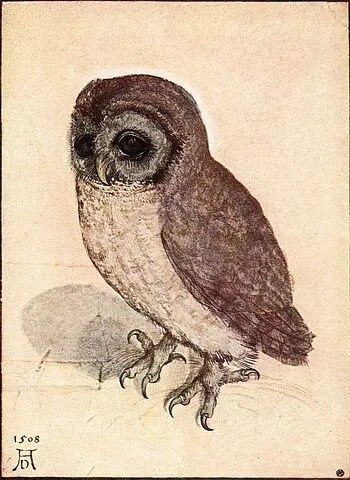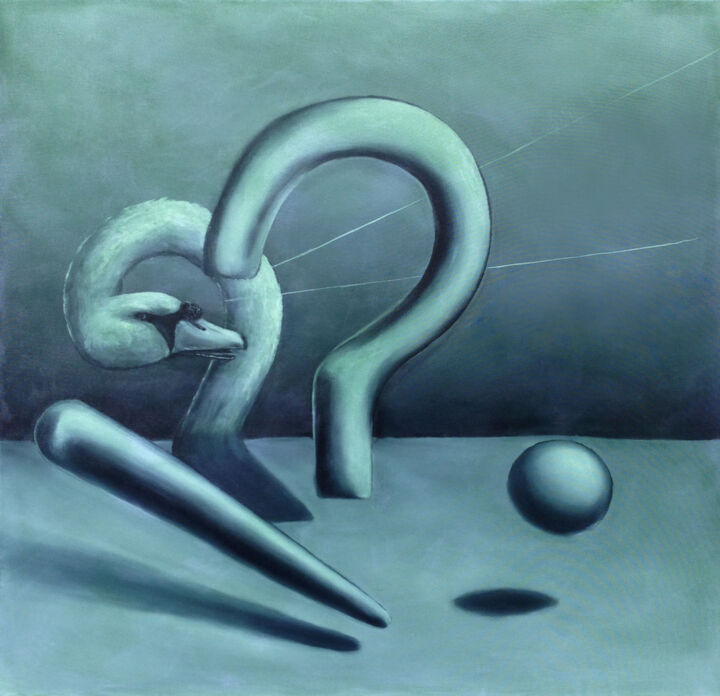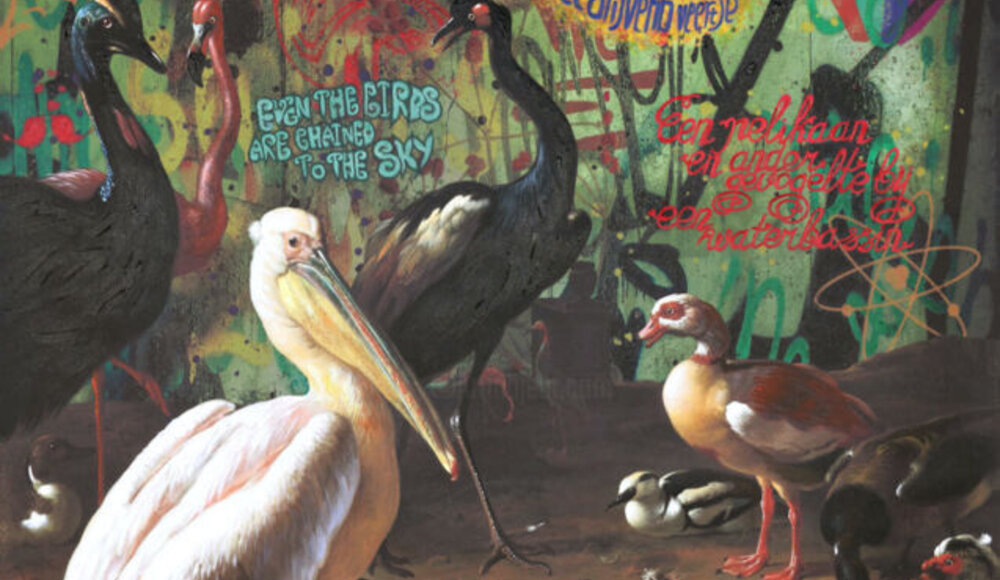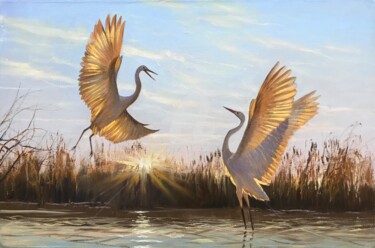 Svetlana Melik-Nubarova, Birds, 2019. Digital photograph / Manipulated photograph on paper, 62 x 48.7 cm.
Svetlana Melik-Nubarova, Birds, 2019. Digital photograph / Manipulated photograph on paper, 62 x 48.7 cm.
Human beings, creatures indelibly linked to the terrestrial kingdom, have long been intrigued and inspired by the capacity of birds to fly, an ability that has allowed this animal to enjoy both full freedom of action and movement, and the observation of new perspectives on the world. This peculiarity has made birds an extremely interesting subject also in the field of historical artistic, in fact, they have been the protagonists of many masterpieces, where, in some occasions, they have also inspired the features of divinities.
 Oleh Lavrii, Birds in the city, 2021. Oil on canvas, 70 x 70 cm.
Oleh Lavrii, Birds in the city, 2021. Oil on canvas, 70 x 70 cm.

Miloš Hronec, Desire, 2021. Oil / acrylic / spray paint on canvas, 150 x 200 cm.
Birds in the history of art
The history of art is rich in works which, since ancient times, have immortalized birds, as demonstrated, for example, by the cave paintings of Lascaux, made more than 17,000 years ago, and the fresco of the House of the Golden Bracelet in Pompeii, dated between 30 and 35 AD. Also during the Renaissance, these animals enjoyed a great success, appearing in many prints, drawings, watercolors and paintings, among which the realism of The Little Owl, realized by Albrecht Dürer in about 1506, strongly stands out. The watercolor of the German master depicts a small creature full of character and expression, which, exalted in the beauty of its species, is well distinguished from previous depictions of the bird, aimed primarily at emphasizing the character of predator of the night messenger of doom.
 Albrecht Dürer, The Little Owl, 1506 circa. Watercolor. Wien: Albertina Museum
Albrecht Dürer, The Little Owl, 1506 circa. Watercolor. Wien: Albertina Museum
Also the seventeenth century, however, was also rich in works of art depicting birds, as evidenced by the Concert of Birds by Frans Snyders (1601), The Threatened Swan by Jan Asselijn (1650) and The Floating Feather by Melchior de Hondecoeter (1680). An iconic seventeenth-century masterpiece, however, is The Goldfinch by Carel Fabritius (1654), a painting often cited as the most famous work of art, having as its subject a bird. This panel depicts a goldfinch chained to its perch, animal that at the time was a symbol of good health and good fortune. In addition, the popularity of this species of bird, domesticated since the era of the ancient Romans, is also found in other great earlier masterpieces, such as the Portrait of Giovanni I de' Medici with a Goldfinch (1544-1545) by Bronzino and the Portrait of a Child (1494) by Giovanni Antonio Boltraffio, having as their subject pet goldfinches.
 Carel Fabritius, The Goldfinch , 1654. Oil on panel, 33.5 cm × 22.8 cm. The Hague: Mauritshuis.
Carel Fabritius, The Goldfinch , 1654. Oil on panel, 33.5 cm × 22.8 cm. The Hague: Mauritshuis.
As for the nineteenth century, to represent it there are: the book by the naturalist and painter John James Audubon, The Birds of America, containing illustrations of a great variety of birds of the United States, Claude Monet's The Magpie (1869) and Bruno Liljefors's Common Swifts (1886). Monet's painting, done en plein air, depicts a magpie perched on a fence, surrounded by a landscape bathed in the whiteness of snow. Unfortunately, the style, purely impressionist, and the colors of the work were not appreciated by Monet's contemporaries, who, accustomed to the dark academic tones, denigrated the masterpiece. Finally, some representative works of the twentieth century and contemporary, having as subject the birds, are: Peacock and Peacock Butterfly by Archibald Thorburn (1917), (1923), and Bluebird Planter by Jeff Koons (2010-2016).
 Claude Monet, The Magpie, 1868-1869. Oil on canvas, 89×130 cm. Paris: Musée d'Orsay.
Claude Monet, The Magpie, 1868-1869. Oil on canvas, 89×130 cm. Paris: Musée d'Orsay.
 Archibald Thorburn, Peacock and peacock butterfly, 1917. Painting. Private collection.
Archibald Thorburn, Peacock and peacock butterfly, 1917. Painting. Private collection.
Archibald Thorburn, one of Scotland's most renowned wildlife painters, was noted for his strong focus on depicting birds in the wild. In fact, he, who was also vice-president of the Royal Society for the Protection of Birds, often went into the forest in order to search for birds to capture with his art. The painting Peacock and Peacock Butterfly is one of his most famous works, in which a majestic peacock with an elongated tail is set against a background of lush trees, flowers and shrubs. About the bird, the peacock, throughout history, has symbolized multiple concepts, which, often contradictory, can be summarized as follows: resurrection, vanity, good luck, imminent destiny, immortality, evil and good. Therefore, it is difficult to know what meaning Thorburn might have been alluding to in his painting. In terms of the contemporary context, Jeff Koons' sculpture entitled Bluebird planter, which is made of reflective metal and depicts a sparrow, is of considerable impact. Precisely through the use of this material, the American artist has pursued the intention of creating works capable of capturing, or rather reflecting, even what is manifested in the surrounding environment, including the viewer himself.
 Tony Rubino, White peacock, 2022. Acrylic / lithograph on canvas, 61 x 61 cm.
Tony Rubino, White peacock, 2022. Acrylic / lithograph on canvas, 61 x 61 cm.
 Ara Gasparyan, Still life with birds and kettle, 2021. Painting, oil on canvas, 35 x 24 cm.
Ara Gasparyan, Still life with birds and kettle, 2021. Painting, oil on canvas, 35 x 24 cm.
Birds in the artworks of Artmajeur
The historical and artistic popularity of birds has also had a strong impact on contemporary figurative research, as demonstrated by the many works created by the artists of Artmajeur on this theme. To exemplify this interest we find the painting of Lukas Pavlisin, which immortalizes a swan, the mixed media of Wilhem Von Kalisz, having as subject several specimens of birds and the sculpture of Gonul Nuhoglu, depicting a raven.
 Lukas Pavlisin, Nylon, 2017. Oil on canvas, 90 x 90 cm.
Lukas Pavlisin, Nylon, 2017. Oil on canvas, 90 x 90 cm.
Lukas Pavlisin: Nylon
Pavlisin's painting reduces, in a totally innovative way, the figure of a swan to the mere depiction of its neck and snout. This focus is replicated in geometric shapes that, when juxtaposed with the animal, synthesize its forms to the maximum. The attention that the artist pays to this bird is not at all devoid of meaning, as the swan has often been depicted in the history of art, in particular, being associated with the myth of Leda and the swan. Linked to this legend were made several masterpieces, aimed at illustrating the male sexual resourcefulness, which also makes permissible the deception, in order to achieve sexual union. Examples of what has been said are: Leda with the swan by Jacopo Tintoretto (1570-1575), Leda with the swan by Leonardo da Vinci (1505-1510) and the more explicit Leda with the swan by François Boucher (1742). On the other hand, as far as masterpieces that focused exclusively on the animal are concerned, it is important to mention once again Jan Asselijn's iconic Threatened Swan (1650), where the bird represents Johan de Witt, at the time the political leader of Holland, intent on defending the country from his various enemies. Therefore, the Artmajeur artist's work represents the continuation of a great tradition, which is enriched with new, original and more contemporary points of view.
 Wilhem Von Kalisz,The bird who dares to falli s the bird who learns to fly, 2017. Painting, acrylic/oil/digital print on canvas, 110 x 100 cm.
Wilhem Von Kalisz,The bird who dares to falli s the bird who learns to fly, 2017. Painting, acrylic/oil/digital print on canvas, 110 x 100 cm.
Wilhem Von Kalisz: The bird who dares to falli s the bird who learns to fly
Von Kalisz's mixed media painting reinterprets Melchior de Hondecoeter's masterpiece, The Floating Feather (1680), in a contemporary context designed to make the work extremely relevant. This famous painting takes its name from a detail, namely the small downy feather, which floats on the surface of the water in the foreground. It is important to note that the Dutch master of the Golden Age often delighted in painting birds, taking a particular interest in exotic species, which he depicted with very realistic details. Finally, the work of the artist of Artmajeur is extremely important, because through the actualization of masterpieces of the past it is often possible to bring the contemporary public closer to the highest tradition.
 Gonul Nuhoglu, Armageddon, crow 5, 2019. Sculpture, bronze / cast on other substrate, 14 x 35 x 14 cm / 4.00 kg.
Gonul Nuhoglu, Armageddon, crow 5, 2019. Sculpture, bronze / cast on other substrate, 14 x 35 x 14 cm / 4.00 kg.
Gonul Nuhoglu: Armageddon, crow 5
The subject of Nuhoglu's realistic bronze sculpture is a raven, iconic animal in art history that has often, and unfairly, been demonized. In fact, this misunderstood and mysterious bird appears in such masterpieces as: Andrew Wyeth's Study of Crows (1944), Vincent van Gogh's Wheatfield with Crows (1890), Pablo Picasso's Woman with a Crow (1904) and Caspar David Friedrich's The Crow Tree (1822). Returning to Nuhoglu's sculpture, what might the artist have been alluding to by depicting a raven? Although this animal encompasses infinite opposing meanings, there is one aspect that we find in all of its interpretations, regardless of culture or time, and that is passage. In fact, the raven has always been associated with a passage from one state to another: from ignorance to knowledge, from life to death, from good to evil or from night to day. Therefore, the sculpture of the artist of Artmajeur probably invites us to change, to a personal transformation that is not always negative, but often necessary for a profitable evolution of our being.


 Olimpia Gaia Martinelli
Olimpia Gaia Martinelli























